WATER IN DESERT WITH A MAGIC WAND
Open 12 Wells and 70 Palms configuration options
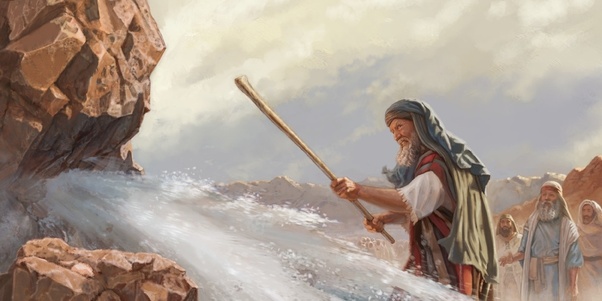
12 WELLS AND 70 PALMS
Like the Moses myth overall, there is little reason to accept the 12 wells and 70 palms at Elim or Aileim as a historical detail. Explaining the mystical and astrological meaning of the 12 wells/fountains and 70 trees, in On Flight and Finding (De Fuga 33:184–186) Philo remarks:
…twelve is the perfect number, of which the circle of the zodiac in the heaven is a witness, studded as it is with such numbers of brilliant constellations. The periodical revolution of the sun is another witness, for he accomplishes his circle in twelve months, and men also reckon the hours of the day and of the night as equal in number to the months of the year, and the passages are not few in which Moses celebrates this number, describing the twelve tribes of his nation, appointing by law the offering of the twelve cakes of shewbread, and ordering twelve stones, on which inscriptions are engraved, to be woven into the sacred robe of the garment…
He also celebrates the number seven, multiplied by the number ten; at one time speaking of the seventy palm-trees by the fountains, and in other passages he speaks of the elders, who were only seventy in number, to whom the divine and prophetical Spirit was vouchsafed.
Thus, it was the opinion of this Jewish philosopher 2,000 years ago that the number 12 was struck upon because of its zodiacal symbolism. In the same regard, while Philo sees the 70 as seven multiplied by 10, astrotheologically the number 70 represents the dodecans or 72 divisions of the zodiacal circle into five degrees each, a motif like the 12, which is found commonly in many mythologies, such as exhibited by the gods of Egypt, Greece and Rome. It is possible that Philo wished to see “seven” because the number “exerts great influence upon the development of living beings and plants,” as the Jewish philosopher Aristobulus of Paneas (c. 160 BCE) purportedly asserted.
The 72 descendants of Jacob/Israel are said to have reproduced in Egypt in “rabbit-like rapidity,” doubling their population every three or so decades, to the point where they purportedly had 600,000 men four centuries later. This clearly mythical motif likely has to do with the 72 dodecans, a number frequently shortened to 70. The 72 descendants and 70 elders or disciples would symbolize the same mythical theme.
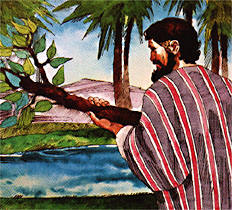
WATER AND MAGICAL WOOD
During the desert sojourn, two or three million people and hundreds of thousands of animals would require a huge amount of water. One must ask why the good Lord initially gives these thirsty travelers “bitter water,” as is the name of the well, Marah, where the Israelites end up at Exodus 15:25? Here apologists try to excuse Yahweh’s abuse of his chosen by claiming God is “testing” them. But they have already endured enough, so why let them suffer in this manner?
25 Then Moses cried out to the Lord, and the Lord showed him a piece of wood. He threw it into the water, and the water became fit to drink. Exodus 15:25
In The Exodus Case, Möller calculates that the Israelites and their livestock would have needed some 8,000 cubic meters of water per day. This massive requirement Moses supposedly achieved by throwing the wood from a particular tree into the bitter waters at Marah. However, no such magical tree wood can be discerned, and water-producing miracles can many be found within the realm of mythology.
THE 12 WELLS
In addition, the 12 wells at Elim (“palms”) as discussed at Exodus 15:27 served as the last natural source the Israelites would come across for the next 38 years, as they eventually relied on other miracles of Moses to provide them with water. Again, the story has an unreal air about it and possesses mythical elements, to be discussed later.
27 Then they came to Elim, where there were twelve springs and seventy palm trees, and they camped there near the water. Exodus 15:27

STRIKING THE ROCK
6 I will stand there before you by the rock at Horeb. Strike the rock, and water will come out of it for the people to drink.” So Moses did this in the sight of the elders of Israel. Exodus 17:6
In Exodus, Moses is depicted as striking a rock, from which fresh water magically issues forth. And, thirty-eight years after the first rock-smiting, the prophet is portrayed as repeating this water-producing miracle.
11 Then Moses raised his arm and struck the rock twice with his staff. Water gushed out, and the community and their livestock drank. Numbers 20:11
Regarding these two episodes of producing water miraculously, Wheless remarks:
Here we have the desert of Sin [Exod 16:1–3] and the desert of Zin, and two waters Meribah, but thirty-eight years apart, and each with entirely different circumstances…. In either event, so far as revealed, this is about all the water that the millions of Chosen and their millions of cattle had to drink in the terrible wilderness for almost forty years.
We can hardly be expected to accept these supernatural tales as “historical facts,” and we shall see that this motif is mythical, found in the traditions of other cultures.
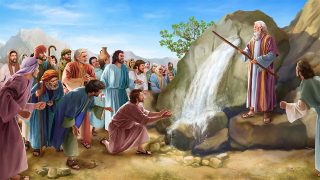
Moses brings water out of the rock, (de Hondt, Figures de la Bible, 1728
Like Moses, Dionysus (Bacchus), strikes fountains of wine and water out of the rock. Almost all the acts of Moses correspond to those of the Sun-gods
It is related in the hymns of Orpheus, that Bacchus had a rod with which he performed miracles, and which he could change into a serpent at pleasure. He passed the Red Sea, dry shod, at the head of his army. He divided the waters of the rivers Orontes and Hydaspus, by the touch of his rod, and passed through them dry-shod. By the same mighty wand, he drew water from the rock, and wherever they marched, the land flowed with wine, milk and honey.
WATER FROM A ROCK – MOSES
Like that of the manna/honey, the miracle of producing water from a rock too must be considered as myth, concerning which Walker relates:
Moses’s flowering rod, river of blood, and tablets of the law were all symbols of the ancient Goddess. His miracle of drawing water from a rock was first performed by Mother Rhea after she gave birth to Zeus, and by Atalanta with the help of Artemis.
In his Hymn to Zeus (28ff), Greek poet Callimachus (310/305–240 BCE) writes that the mother of the gods “Rhea causes the first waters to burst from the rocks of the sacred hill where Zeus was born.” Pausanias (3.24.2) tells us that the Greek maiden Atalanta “produced water from a stone in the wilds of Arcadia by striking the rock with her javelin.”
Mithraic expert Dr. Maarten Jozef Vermaseren and Dutch archaeologist Dr. Carel Claudius van Essen also summarize a number of ancient water producing miracles:
Mithras is by no means alone in the performance of this miraculous deed, by which a spring is created. In the Veda it is Indra, who after drinking the potion of immortality, the soma, proceeds to subdue Vŗta, the snake which encircles the spring and watches over it and, thus makes the water accessible to mankind. Siva too in his turn opened up many springs and streams by a blow of his trident. In Greek mythology there is Poseidon who struck water from the rocks by means of his trident, and it is remarkable that, apart from the Acropolis, he also caused new springs to arise in Atlantis… In this respect Dionysus also was a miracle-worker, and according to Philostratus, Imag., I,14 the Earth will even favour him in this… Atlanta, returning from hunting, also strikes a rock with her spear and creates a spring, and it would be easy to add a great many further examples of this phenomenon. Just as Prometheus provided mankind with fire, there are gods, heroes and saints, who have presented man with water, especially the wholesome liquid that is imbued with immortality.
As we can see, this sacred act of miraculously producing water is common and not unique to Jewish myth. In this regard, an early instance of the sun god conjuring fresh water from the earth can be found in the Sumerian text “Enki and Ninhursag,” which also discusses a fertile “promised land,” thousands of years before the Exodus tale was composed.
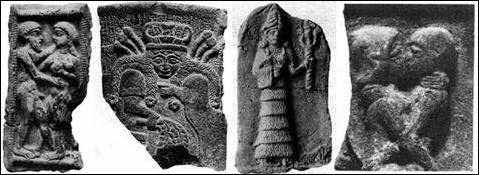
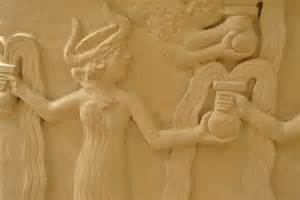
MITHRA SHOOTS ARROW AT ROCK
One of the more famous examples of miraculous water-production occurs with the Perso-Roman god Mithra “shooting at the rock,” from which flowed water, a scene similar to “Moses smiting the rock” (Num 20:11) in Christian iconography. Describing a particular Mithraic image of this scene, Vermaseren and van Essen further state:
Mithras is seated on a rock with a bow in his hand, from which he shoots an arrow at another rock, thus producing an abundant flow of water. In front of this rock there kneels a person in Oriental dress and sometimes there are two, who immediately drink from the water… Whatever changes might have been introduced, the monuments clearly reveal that the gemini fratres [twin brothers] in the dipinto [painting] are not the two Dioscuri, but Cautes and Cautopates, who in the Mithras reliefs are usually represented as torchbearers. The two figures in Oriental dress are, according to some statements from antiquity, hypostases [supporting figures] of the Sun-god Mithras. These symbolize him in the morning and in the evening, and are respectively Sol Oriens [“Sun East”] and Sol Occidens [“Sun West”]. They are already present at Mithras’ birth from the petra genetrix [generative rock] and sometimes they even act as assistants. Here, however, they enjoy the miracle by which Mithras with a shot from his bow releases the fons concluse petris [“rock-bound spring”]. In the same way as the petra genetrix symbolizes the vault of heaven from which the god is born, and the grotto (antrum), where Mithras slays the bull, is sometimes studded with stars, so the spring is here enclosed within the grotto, i.e., the vault of heaven.
Fig. 51. Mithra shooting an arrow into a rock to produce water, c. 2nd cent. AD/CE. Mithraeum at Neuenheim, Germany
The sun is born each morning, out of the “cave,” “grotto” or “rock,” symbolizing not only the vault of heaven or tomb of the underworld but also the womb of the earth mother. In Greek, the noun for “rock,” petra, is feminine, while in Latin, “mother” is mater, the root of “material” and “matter.” The virgin-birth motif for Mithra is prominent in the Persian version of his myth, in which the virgin goddess Anahita is represented as the god’s mother.
The torchbearers on either side of the solar Mithra represent the sunrise or morning and sunset or evening, as well as the vernal and autumnal equinoxes. Thus, the motif of the godman between two others, as in the Jesus myth with the “thieves” crucified on either side, symbolizes the central sun surrounded by the morning and evening suns. In this regard, it is noteworthy to recognize that the cross has denoted the sun since remote antiquity.
Noting the connection between the Mithraic water-producing motive and not only the Moses but also the Jesus myth, mythicist Ken Humphreys comments:
We have evidence that Mithras performed at least one miracle: the god released life-giving water from a rock by firing an arrow. Regurgitated in the story of Jesus, the god of the Christians claimed himself to offer, or even be, “living water”:
“All who drink once of the water that I will give them shall never thirst anymore.” John 4.14
As we have seen, controlling and producing water is a solar attribute, as the sun was seen to bring about the rains in their season.
SPIRITUAL ROCK WATER
In a statement against the literal interpretation of the biblical motif, the apostle Paul (in Corinthians) tells us that Moses’s rock was not “real” but spiritual, symbolic of Christ:
4 and drank the same spiritual drink; for they drank from the spiritual rock that accompanied them, and that rock was Christ. 1 Cor 10:4
As we can see, there are a number of parallels and precedents for this spiritual or mythical “miracle” in religions and mythologies of different cultures. There seems little scientific reason to accept one supernatural rendition as myth and another as history.
KRISHNA STRIKES ROCK
In the Hindu myths, in addition to Indra and Shiva as openers of springs and wells we also find the story of Krishna smiting a rock with his chakra or discus, causing a “spring of sweet water to bubble up,” reminiscent also of above verse Exodus 15:25, in which Moses magically changes brackish water to “sweet water.”
POSEIDON STRIKES ROCK
In his contest with the goddess Athena over the city subsequently styled “Athens” for the winner, the Greek god Poseidon also “smote the rock,” striking the Acropolis with his trident (three pronged spear) to create a salt-water stream, pool or sea, a myth related by Herodotus and fleshed out by later writers. One of these later authors, Apollodorus (2nd cent. BCE), remarks (3.14.1):
So Poseidon came to Attica first and struck his trident on the Acropolis producing a sea, now called Erechtheis.
One might suggest that the creation of an entire sea rates as a more impressive miracle than simply bringing forth a relatively small spring. It appears to be a matter of bias which supernatural tale we choose to believe as “history,” reflecting “real” divine miracles.
DIONYSUS (WINE & MILK)
The text Imagines traditionally attributed to Greek sophist Philostratus of Lemnos (b. c. 190 AD/CE) is part of a corpus composed evidently by two or three individuals of the same name, dating to the second and third centuries AD/CE. In this text (1.14), we read:
We must not be surprised if in honour of Dionysus the Fire is crowned by the Earth, for the Earth will take part with the Fire in the Bacchic reveal and will make it possible for the revelers to take wine from springs and to draw milk from clods of earth or from a rock as from living breasts…. Megaera causes a fir to shoot up beside him and brings to light a spring of water, in token, I fancy, of the blood of Actaeon and of Pentheus.
Centuries earlier, Athenian playwright Euripides (480–406 BCE) told a similar Dionysian tale of miraculously produced wine, milk and honey.
Professor Steinthal, speaking of Dionysus (Bacchus), says: Like Moses, he strikes fountains of wine and water out of the rock. Almost all the acts of Moses correspond to those of the Sun-gods.
Mons. Dupuis says: “Among the different miracles of Bacchus and his Bacchantes, there are prodigies very similar to those which are attributed to Moses; for instance, such as the sources of water which the former caused to sprout from the innermost of the rocks.”
In Bell’s Pantheon of the Gods and Heroes of Antiquity, an account of the prodigies attributed to Bacchus is given; among these, are mentioned his striking water from the rock, with his magic wand, water from the rock, his turning a twig of ivy into a snake, his passing through the Red Sea and the rivers Orontes and Hydaspus, and of his enjoying the light of the Sun (while marching with his army in India), when the day was spent, and it was dark to others.